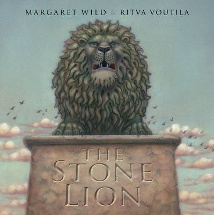The Stone Lion by Margaret Wild

Ill. by Ritva Voutila. Little Hare, 2014. ISBN 9781921894855.
(All ages) The stone lion crouched on his pedestal guarding the
entrance to the town's library. Lifelike in size and appearance, he
was 'so real, so fierce and cold that small children scuttled past
at the sight of him' and in stark contrast to the warm, inviting
environment that the concept of a library portrays. Only Sara,
homeless and alone, weeping gently and cuddling a small bundle that
is her baby brother snuggled into his paws, while Ben the librarian
leaned against him at lunchtime while he ate his sandwiches and
read, laughing occasionally. Even though the gargoyle perched on the
portico above his pedestal explains Sara's distress and Ben's
delight, the stone lion has no understanding of such feelings. He
just wants to come alive so he can run and prowl and leap - to just
move. He imagines himself strolling along the street in front of the
library and running in the park across the road.
'Sometimes, stone animals are granted a chance to become warm,
breathing creatures' the gargoyle tells him, 'But it is for a very
short time only, and they must desire it greatly, with a generous
heart.' Even though the lion does desire it greatly with no apparent
ability to feel, it seems like a dream that will be unfulfilled.
Then winter comes and it hits hard. Snow falls and lies deep, and
once again Sara comes to the lion's feet, sinking onto the steps and
going limp. A snowflake falls on the baby's nose and he wails,
waving a tiny fist, and a stab of pity pierces the lion's heart . .
.
This is a picture book for all ages with many levels of complexity.
Accompanied by evocative pictures created with oil pastels on grey
velour paper which portray the mood and atmosphere perfectly, this
story is a mixture of fantasy, fairy tale and fable. The lion at the
end of the story is not the lion of the beginning, much like the key
characters in The Selfish Giant and The Happy Prince
opening the way for in-depth and comparative studies of these texts.
How can a single act of kindness make such a difference to so many?
Teaching
notes are available at the publisher's website.
Barbara Braxton